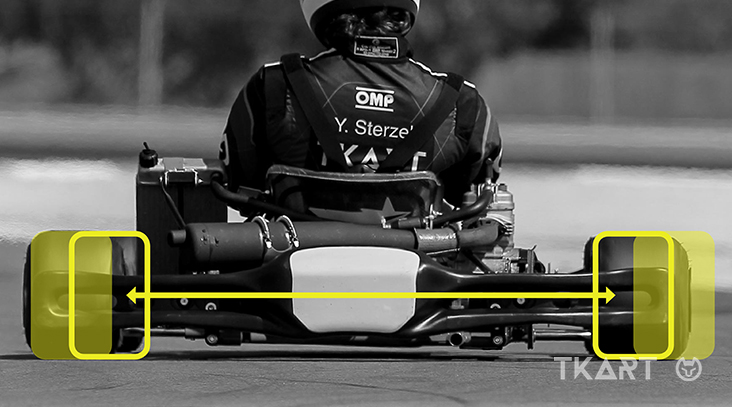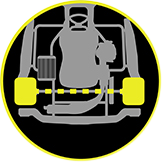REAR TRACK WIDTH
Rear track width determines the amount of centrifugal force that discharges on the front outside tire. This discharge, in turn, determines a shift in the impact of vertical forces, causing the rear inside tire to lift more or less. Specifically: the wider the rear track, the higher the rear inside tire lifts off the ground and, therefore, the greater the weight that shifts to the front end of the kart, causing over-steering.
Another combined effect is given by the length of the axle segment that extends from the outside bearing to the wheel hub. Of course, the wider you set the rear track, the longer this segment gets and so the more it flexes, causing the entire axle to be softer. The result of this is lower grip for the rear load tire and, again, a tendency towards over-steering. The opposite happens with a narrower setting.
TIRES AND GRIP
Variations in track width modify the rear tire footprint: a narrower track setting causes the axle to flex less (even less if it’s a stiff axle) and so causes a title in the footprint, with greater load on the outside; vice versa, a wider track causes the rear tires to do more “work” on the inside. The other key effect of a narrower track is greater rear-end bite. In high-grip track conditions and with soft tires this often causes the rear end to “bounce” sideways. To the contrary, a wider track gives you less rear grip, but allows the kart to slide in more uniform and progressive manner. Of course, on a slick track (without much rubber down) you’ll want a narrower setting: this will give you just the grip you need, without making the kart jumpy.
TRACK WIDTH UP FRONT
Front track width influences front-end grip (though, of course, it necessarily “works” in relation with rear track). The general rule is this: the wider you go, the greater the grip, especially in wide fast bends; the narrower you go, the more the kart under-steers and the more agile it becomes in changes of direction and tight bends.
 Exclusive Content
Exclusive Content



